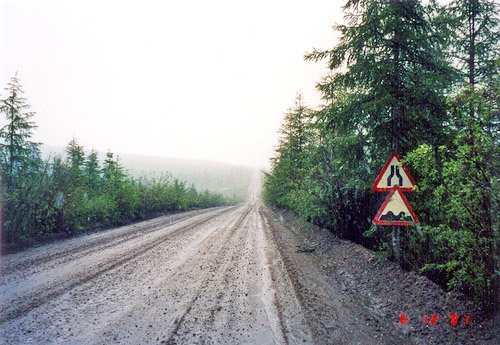

I have some general notes about Solzhenitsyn for the HIS 242 course.
I am tempted to say that Solzhenitsyn's book, One Day in the Life of Ivan Denisovich, is probably the most important book of Russian literature to appear in the twentieth century. In fact, I might go even further and say that it is the single most important Russian book of any type to appear in Russia in the century, but we can save that debate for another time and place.
Solzhenitsyn had served, and was decorated, in the Red Army during the World War II, but some off-hand criticisms of Stalin in a letter to a friend provided the pretext for his arrest and subsequent sentence to eight years of hard labor in the Soviet prison camp system, aka the GULAG. Released after Stalin's death in 1953 and pardoned later after Khrushchev's Secret Speech denunciation of Stalin's cult of personality, Solzhenitsyn began to write while working as a mathematics teacher. Actually, he had been writing for a long time; while in the GULAG he memorized stories, detailed notes and passages.
With the Thaw in the Soviet Union and Khrushchev's de-Stalinization campaign, Solzhenitsyn took the bold step to send his manuscript of One Day to Aleksandr Tvardovskii, 1910-1971, who was then chief editor of Новый Мир (Novyi mir, "New World"), a Soviet literary magazine which had the reputation of being oriented in a "liberal" direction--that would be a "Soviet" definition of liberal. Tvardovskii was enthusiastic about Solzhenitsyn's book, and though there was opposition from the editorial board of the journal, he decided to take the chance and try and get One Day published. But Soviet censors would not allow most of what Solzhenitsyn had written to be printed. So, Tvardovskii, who was a member of the Communist Party central committee, sent the manuscript to the central committee to get around the censors. After lengthy discussion it was Nikita Khrushchev himself, as head of the party, who gave his personal approval for publication, allegedly claiming to his party colleagues, "There’s a Stalinist in each of you; there’s even a Stalinist in me. We must root out this evil." (via wikipedia, Peter Benno, "The Political Aspect", in Max Hayward and Edward L. Crowley, eds., Soviet Literature in the Sixties (London, 1965), p. 191)
So, the book did appear in 1962 in the pages of Novyi mir, with some censorship and required changes, such as the title. The problem was, and Solzhenitsyn acknowledged this in The Oak and the Calf (see below), that he had just missed the boat. The de-Stalinization campaign had already peaked; Khrushchev had denounced modernist art at the Moscow Manege Exhibition; there were tense relations between the Soviet Union and Communist China; the 22nd Communist Party Congress was over (the last rites of de-Stalinization when Stalin's embalmed body was removed from Lenin's Mausoleum on Red Square; the Cuban Missile Crisis exposed some of the weaknesses of the USSR. Khrushchev's own hold on power was slipping away. There was less and less enthusiasm--if there had really ever been any--for political, or literary, controversy.
As the political climate began to change, it soon became impossible for Solzhenitsyn to get published--although "Matryonna's House" appeared in 1963--but for a while at the end of Khrushchev's time in office, One Day legally circulated and was actually studied in schools. By the end of 1964, when Leonid Brezhnev ousted Khrushchev from power in the Little October Revolution, the political climate changed to a far more status-quo order. Solzhenitsyn realized that he was not going to get published and did not really try. Instead, he bided his time, laid low and continued to work, especially on The GULAG Archipelago. Most of Solzhenitsyn's works began to be informally circulated in Moscow and throughout the country in illegal, typescript forms. This was called "samizdat," self-published, underground literature.
One Day in the Life was a huge sensation, both in the Soviet Union and also in the West--not long after the Soviet publication an unauthorized translation appeared abroad. Solzhenitsyn, who, of course, had personal experience with the Soviet prison camps system, had leveled a powerful indictment at the Soviet regime. The book showed that the entire Soviet political edifice was built on a lie, the persecution and forced labor of the country's citizens and terror. It had taken exceptional courage for Solzhenitsyn to write and then publish the book, and he later elaborated on his camp experiences in The GULAG Archipelago where he tried to preserve the stories, memories and lives of the millions who had perished in the purges and the camps--it is a profoundly depressing book, but one that should be read. Solzhenitsyn felt that he had a moral duty to write what he did and that gave him the courage to challenge both the Soviet Regime, and indeed, all of humanity to be human.
Some recommended online lectures and websites:
- Solzhenitsyn has recounted many of the circumstances surrounding the publication of One Day in his autobiographical remarks, The Oak and the Calf, which he had begun in April 1967 and periodically returned to add further commentary to his account in 1971, 1973 and 1974.
- One Day in the Life of Ivan Denisovich (Russian)
- See the detailed map of the Soviet GULAG with links to pictures, information and sources on each camp.
- For extra credit please suggest to your instructor a relevant website for this unit of the course. Send the title of the site, the url and a brief explanation why you find the information interesting and applicable to the material being studied in this unit.
-